How Chess Pieces Move: The Complete Chess Pieces Guide for Beginners
How chess pieces move? Once you’ve learned all there is to know about the chessboard and rules of chess, it’s time to see how those figurines you’ve just arranged on their starting squares move.
One thing to remember from the very beginning is that pieces have different values. I’m going to start the presentation in ascending order.
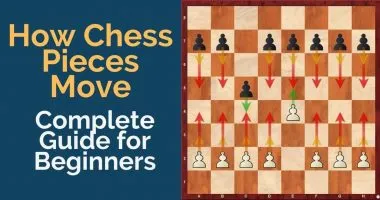
1. The Pawn – How Chess Pieces Move
Considered to be the least valuable piece on the chessboard, the pawn is worth only 1 point. However, you will learn in time that they can be very powerful and, just like an army of skilled soldiers in a battle, open the way for the rest of the army towards the opponent’s king.
The pawns can only move forward and can never go backward – an important point to remember when deciding to advance one. (If you often do not know what chess move to play, you must read this next.)
They advance one square at a time, except for their first move when you have the option of advancing them 2 squares. This can only happen once for each pawn during the game – when they leave from their starting position.
For example:
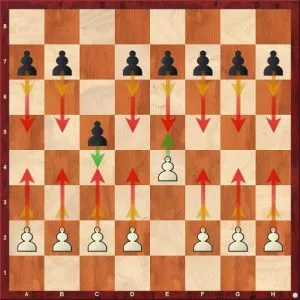
Here, we can see that all the pawns on the 2nd and 7th rank still keep the option of advancing one or two squares at a time. The pawns on e4 and c5, however, can only advance one square at a time from now on.
When the pawns meet enemy pieces on their way, things change.
Pawns can capture in diagonal (again, moving only one square in that direction) and never forward. If an enemy piece is placed in front of our own pawn, then that pawn is blocked and will only be able to move once that piece has vacated the square it is on or when it will have some other piece to capture in diagonal:
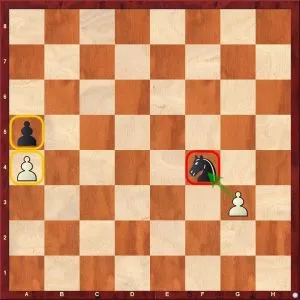
In the diagram above we can see that the white pawn on g3 can capture the black knight on f4 and so it will move one square in a diagonal.
The pawns on the A-file, however, are blocked and cannot advance any further.
One of the most amazing features of the pawns is that they can turn into any other piece (except the king) if handled correctly. If any of our pawns reach the last rank, then we have the right to replace it with any piece we like.
The most common choice for such a promotion is a queen – the most powerful piece on the chessboard – and it will replace the lucky pawn (we will remove the pawn from the board and place the queen on the exact same square the pawn was on):
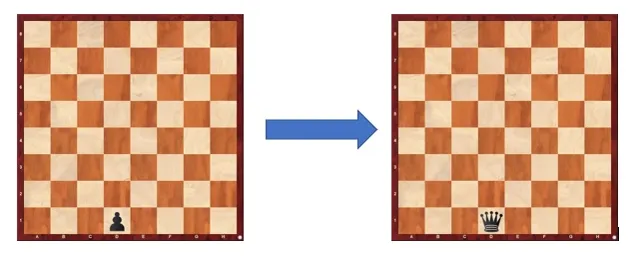
Next on our list, in the order of their value, are the bishop and the knight, which are equal as value, and they are each considered to be worth 3 points or pawns.
2. The Bishop – How Chess Pieces Move
We start the game with two bishops, each placed on a square of a different color. Bishops keep their color throughout the whole game and you will hear most chess players refer to them as the “light-squared bishop” or “dark-squared bishop”.
You can learn more about good and bad bishops next.
Bishops move in a diagonal, as many squares as you like. They can move both forward and backward, but cannot jump over pieces:
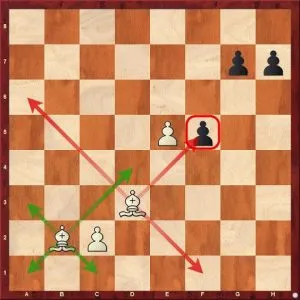
In the diagram above we have both bishops.
The one on b2, the dark-squared one, can only move on a1, c3 and d4, as then its diagonal will be blocked by our own pawn on e5. It can also move on a3 and c1.
The bishop on d3, our light-squared one, has more freedom of movement. It can go anywhere on the f1-a6 diagonal, it could capture the black pawn on f5, but it can’t move backward because of our own pawn on c2.
3. The Knight – How Chess Pieces Move
We have reached one of the most fascinating pieces on the chessboard. The knight lives up to its name and is the only piece that can jump over other pieces (both our own and our opponent’s).
When it moves, it creates the shape of an L:
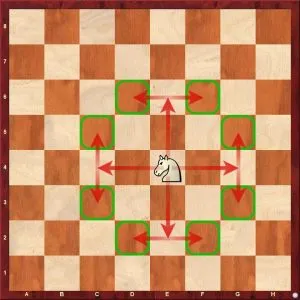
The knight is best placed in the center of the board, as this will give it freedom of movement. As you can see in the diagram above, the knight can jump on 8 different squares when sitting in a central square.
In comparison, it has only two squares available if placed in any corner of the board, for example.
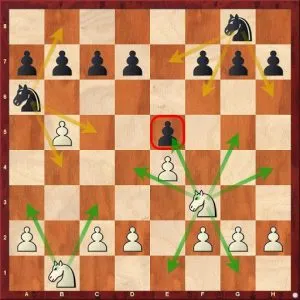
Here we can see the different squares knights can move on from the starting position and after being developed. The knights on b1 and g8 can jump over their own pawns and, by creating the “L” shape end up on one of the signaled squares.
The knight on f3 has already been developed and has many more options than its colleague on b1. Right now, it could even capture the enemy pawn on e5. The knight on a6 is under attack by the pawn on b5 and it could, for example, escape this threat by jumping to b4. Note that when doing so, it will jump over the white pawn on b5. This does not mean it will also capture that pawn.
The knight can only capture the piece that is placed on the square of its final destination (b4, in our case).
4. The Rook – How Chess Pieces Move
Next on our list is the rook, the piece that looks like a castle. The rook is more powerful than the bishop or the knight and is valued at 5 points or 5 pawns.
It can move vertically (on files) or horizontally (on ranks) for as many squares as possible. Just as the bishop, the rook cannot jump over other pieces:
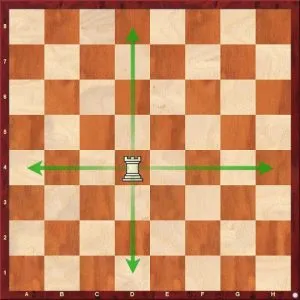
This rook, for example, can move anywhere along with the D file or the 4th rank, as there are no other pieces to hinder it.
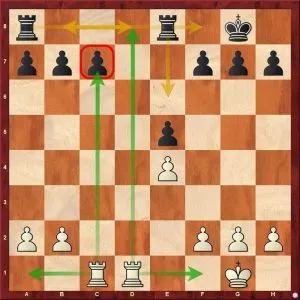
With more pieces on the board, we can see how the rooks can become limited.
The white rooks have more freedom here, as the files they are on have more squares available to move on. The rook on c1 can also capture the black pawn on c7 right now. The black rooks, however, are limited by the black pawns. The rook from a8 can only move along the 8th rank and the rook on e8 doesn’t have much more freedom either.
Want to learn some of the advanced rook strategies? I recommend reading this post on Rook Sacrifice as well as The Importance of Piece Activity in Rooks Endgames.
To sum up the rooks
From this example, we can draw the conclusion that it is important to look after our rooks and place them on files that will allow them to move. The best files for rooks are the open files – these are files that don’t contain any pawn, such as the D-file in our case. If there are no open files in your position, the second-best is the semi-open files.
These are files that contain only one pawn on them, for example, the C-file for our rook on c1. Rooks are usually very passive on closed files, where they have no freedom of movement, such as the A-file for the black rook on a8.
5. The Queen – How Chess Pieces Move
We have finally reached the most powerful piece on the chessboard. The queen is our most valued piece, at 9 points, and it can help us win the game with ease. She can move in any direction she likes – diagonally, vertically, or horizontally, both forward and backward.
The queen does have some restrictions, though – she cannot jump over other pieces nor she can move in an L shape, like the knight:
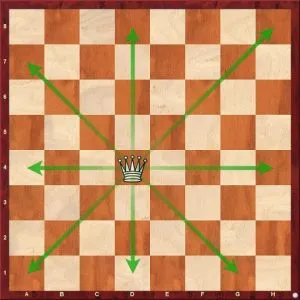
Here you can see all the directions the queen can move in. Let’s see how adding some more pieces on the board affects her power:
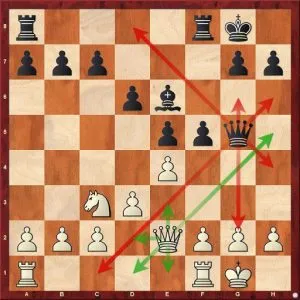
In the diagram above we can see a big difference between the white and black queen. The white queen is slightly more passive. Her counterpart is already eyeing the king and is ready for an attack.
Queens are very powerful when organizing attacks against the king, but it is essential to receive help from other pieces as well. The more pieces and the better they cooperate, the stronger your attack will be.
6. The King – How Chess Pieces Move
We have finally arrived at the king and I have left it for last not because it is the strongest piece, but because it is a special piece. We’ve seen that all the other pieces are given a points value. This does not happen with the king. The king can never be captured, so we will always have him on the board.
The king can, however, be mated and that’s the supreme goal in every game. When that happens, the game has been won. It doesn’t matter how many rival pieces you have captured; it doesn’t matter how many points ahead or behind your opponent you are – the game is over only when the king has been mated.
For this reason, we could conclude that he is the most important piece on the chessboard and we cannot put a value on his head.
The King is not a fast piece; he can only move one square at a time, but he can go in any direction he wants.
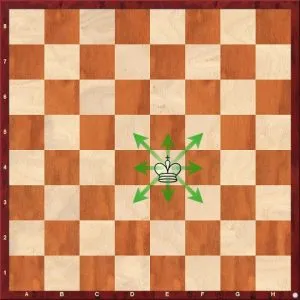
Here you can see all the squares the king can move on when in the center of the board. However, this does not mean that you should aim to bring your king there.
The king is the most vulnerable piece. That is why it should be protected and cared for. The best way to keep him “hidden” and protected is behind the pawns, who will then create a protective shield for their monarch.
When there are no more dangers on the board and the game is entering the final phase the king becomes a powerful piece.
You will find many games where the help of the king is invaluable. He is the one who makes it possible to bring the point home.
As with most of our pieces, the king can capture other enemy pieces, but cannot jump over any piece.
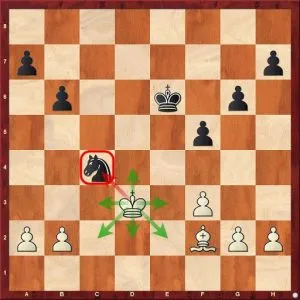
In the diagram above we have an endgame.
Here, the king has advanced towards the center and can now capture the knight on c4, for example. He can also move to any of the squares marked above.
Notice that the square e4 is not marked. That is because the king is not allowed to move there, which brings us to an important point:
When attacked, we say that the king is in check. This is the ultimate threat in the game of chess and we have to stop anything we were doing before and make sure we get our king out of check. There are various ways to do so. The simplest and most obvious one is to simply move the king to a different square, that is not under attack.
Another way to defend against a check is to place a piece in front of the king. Then, we should always check if we can’t capture the piece that is attacking our king. If that is possible, then we could use it as a defensive resource.
Next step? Become a Club Level player in no time!
Give Me 20 Hours and I Will Show You How to become a Club Strength Chess Player!
Get Comprehensive Beginner’s Course 50 % off [use code CHESS50 at checkout]




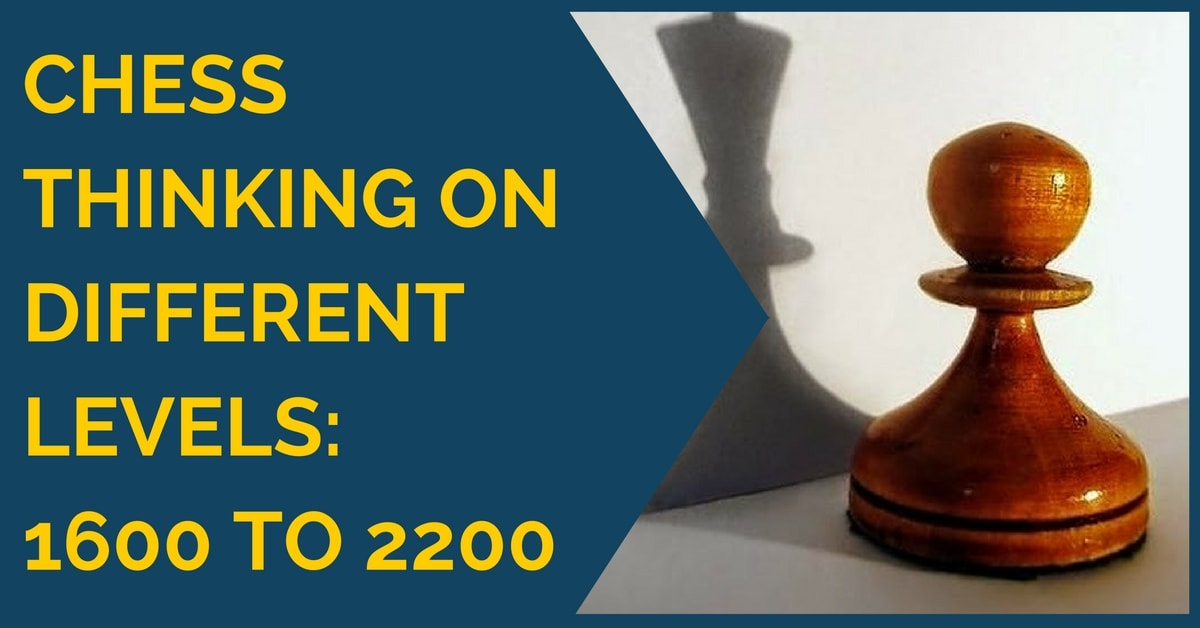
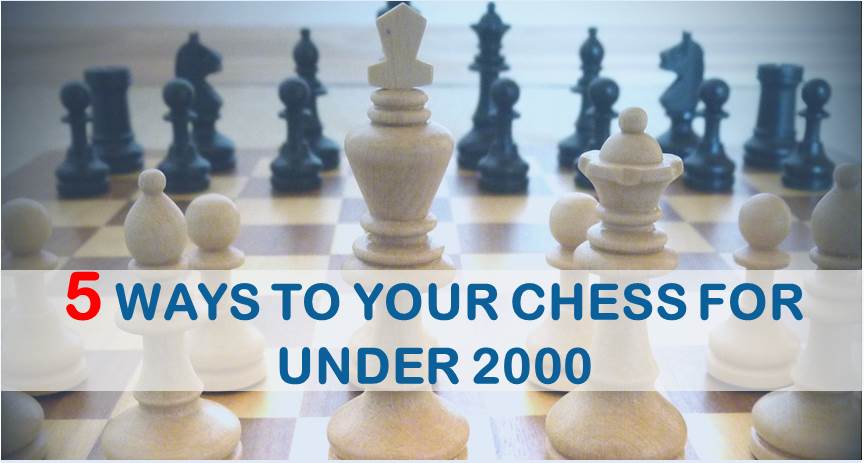




Comments: